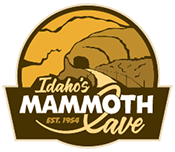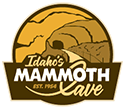Our Story as a Famous Idaho Attraction

If you take the time to drive the dusty mile off the highway, you’ll discover what a beautiful diamond in the rough awaits you, and what a rich history it has. It is a place where ancient lava flows scar the land and where harsh winter winds and snow provide nourishment for exploding wildflowers and lush sagebrush.
Our Story as a Famous Idaho Attraction
When you’re driving through southern Idaho on Highway 75, you’ll see the sign for “Idaho’s Mammoth Cave & Shoshone Bird Museum Of Natural History”, eight miles north of Shoshone.
If you take the time to drive the dusty mile off the highway, you’ll discover what a beautiful diamond in the rough awaits you, and what a rich history it has. It is a place where ancient lava flows scar the land and where harsh winter winds and snow provide nourishment for exploding wildflowers and lush sagebrush.

Our founder, Richard Arthur Olsen, was an eccentric man with an unbelievable love for nature, history, and the outdoors. He was an avid hunter and collector who traveled the world and brought back nearly everything you could imagine. His collection is an unbelievable mix of animal and bird mounts, long-forgotten fossils, and artifacts of ancient people. He was his own taxidermist, and most of the mounted animals you will see were the careful work of his own two hands.

Olsen, The Explorer
As a high school senior, Richard Arthur Olsen, rediscovered the cave in 1954 while hunting bobcats in the area. He was with a girlfriend at the time and stumbled across the entrance by accident. He talked her into exploring the cave with just a single flashlight. He loved to chuckle about how they made their way through the cavern, his excitement and imagination growing the whole time – expecting to find treasure at any moment – his girlfriend, scared and unhappy, cried the whole way in and the whole way out. It was love at first sight for him, and he decided that he wanted to share this beautiful cavern with the world.
He began with several different ideas, deciding first to homestead it under the Small Tracts Act, by raising mushrooms in the perfect dark and damp conditions. You can still walk over the remnants of these mushrooms today as you explore the cave (but don’t eat them, because they have grown poisonous over such a long period of time!).

Olsen, The Explorer
As a high school senior, Richard Arthur Olsen, rediscovered the cave in 1954 while hunting bobcats in the area. He was with a girlfriend at the time and stumbled across the entrance by accident. He talked her into exploring the cave with just a single flashlight. He loved to chuckle about how they made their way through the cavern, his excitement and imagination growing the whole time – expecting to find treasure at any moment – his girlfriend, scared and unhappy, cried the whole way in and the whole way out. It was love at first sight for him, and he decided that he wanted to share this beautiful cavern with the world.
He began with several different ideas, deciding first to homestead it under the Small Tracts Act, by raising mushrooms in the perfect dark and damp conditions. You can still walk over the remnants of these mushrooms today as you explore the cave (but don’t eat them, because they have grown poisonous over such a long period of time!).
After the mushroom venture didn’t work out as he had planned, he decided to share his dream with the world. At the time, he had just a single diesel-powered generator that powered lights in the cave. This didn’t prove too successful either because if the generator ran out of fuel – or on most occasions, just plain broke down – it would leave the visitors stranded in the dark, and Richard would have to go down and rescue them. Later on, he decided to use propane lanterns that lasted many hours. Today, we use battery-powered lanterns that have proven very safe, dependable, and successful.
Building A Home
Richard built his home next to the cave with the help of his oldest children. It is a four-story, A-frame that was built almost entirely out of wood scraps from a local sawmill. It still stands today, along with the first, original museum built in the same manner.
In the 1960s, during the Cold War, the U.S. Government approached Richard about using the cave for a civil defense shelter in case the United States was ever under attack. They promised him a good graveled road if he would let them put food and supplies in the cave for 8,000 people. There, they built a large platform and supplied food and water there for the next 20 years.

Building A Home

Richard built his home next to the cave with the help of his oldest children. It is a four-story, A-frame that was built almost entirely out of wood scraps from a local sawmill. It still stands today, along with the first, original museum built in the same manner.
In the 1960s, during the Cold War, the U.S. Government approached Richard about using the cave for a civil defense shelter in case the United States was ever under attack. They promised him a good graveled road if he would let them put food and supplies in the cave for 8,000 people. There, they built a large platform and supplied food and water there for the next 20 years.
Plan A Visit
As one of the most unique things to do in Idaho, the cave has a well-established trial, and lanterns are provided. If you have flashlights, they are always good to bring along. Wearing a light jacket is recommended because the cave keeps a consistent 41 degrees. It is a self-guided tour that takes about half an hour. You walk about a quarter-mile in and a quarter-mile out. With special permission, experienced spelunkers may go to the very end of the cave that goes another quarter-mile from the stopping point. There is no trail there, and it is difficult walking.
We hope that when you drive by our “Mammoth Cave” sign on the highway, that you take the chance and experience something rarely found. We guarantee you will find it worth your while and will look forward to coming back again and again.

